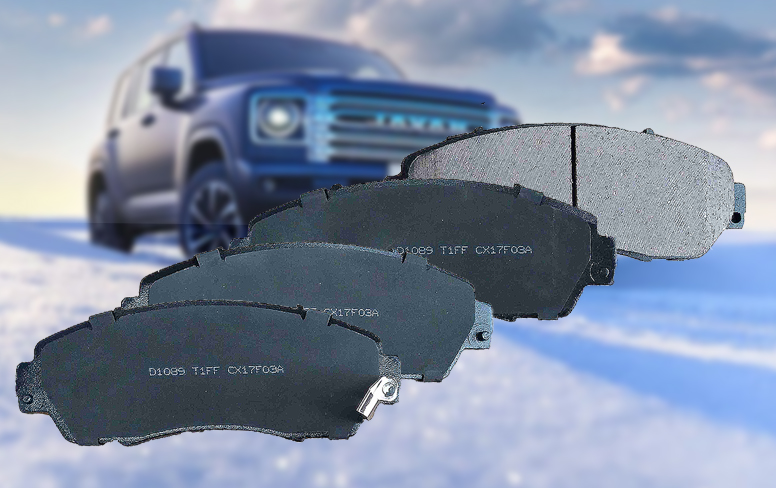+86 153 7870 3202
+86 153 7870 3202
As the "last line of defense" in a car’s safety system, the condition of brake pads directly impacts the safety of every journey. Yet most drivers only think about replacing them when they fail, unaware that choosing the wrong material or missing replacement timelines can pose serious safety risks. Today, we’ll break down everything you need to know about brake pads with expert knowledge and practical tips.
Table of contents:
Choose the Right Material: A Guide for Different Scenarios
Replacement Timing: Avoid 3 Myths, Master 3 Check Methods
Extend Lifespan: 4 Habits That Save Hundreds in Maintenance
Conclusion: Safety Matters More Than Saving Money
The performance gap between brake pads stems from their materials. The three mainstream types on the market each have distinct strengths—blindly chasing "high-end options" can backfire:
These pads use metal fibers as the core friction material, delivering strong braking force at an affordable price (usually 30–60 per set). They’re ideal for city driving with frequent stops and starts. However, their drawbacks are equally obvious: metal components easily generate friction noise with brake discs, braking response is slower in low temperatures, and wear rate is high—drivers who brake hard frequently may need replacements after just 30,000 km.
Despite the name, they aren’t made of pure ceramic but are molded from composite materials like ceramic fibers and aramid fibers, now widely used from luxury cars to family vehicles. Their key advantages include: maintaining a stable friction coefficient of 0.45–0.55 even at 650°C, far less thermal fade than traditional materials; zero metal friction noise, minimal brake dust deposition on wheels; and a lifespan 50% longer than semi-metallic pads. They’re highly recommended for drivers who frequently take highways or mountain roads. The tradeoffs? Slightly slower initial braking response in cold weather and higher prices (70–120 per set).

Tailored to EVs’ heavy weight and frequent regenerative braking, these pads have reduced metal content and added lubricating components like graphite. They enable smooth braking with regenerative systems and reduce brake disc wear, now standard on over 65% of newly launched high-performance EVs.
Myths like "replace every 50,000 km" or "change front and rear pads together" are widespread—scientific judgment depends on actual wear:
• Myth 1: Blindly following fixed intervals
After 50,000 km, pads in city traffic may wear 3x faster than those used for highway commuting, and mountain downhill driving doubles wear rate. Relying solely on mileage or time either wastes money or misses safety windows.
• Myth 2: Waiting for the "metal scraping sound"
Continuous high-pitched squealing means friction material is almost gone, and the metal backing plate is scraping the disc—costs jump from hundreds to thousands of dollars.
• Myth 3: Replacing front and rear pads together
Front wheels bear 70–80% of braking force, so front pads wear much faster. Typically, front pads need replacement twice for every rear pad change.
1. Check thickness: Find the safety threshold
New pads have 10–12 mm of friction material. Prepare for replacement when worn to 3–5 mm, and replace immediately if under 3 mm. Most models let you inspect through wheel gaps with a flashlight; some have wear indicator tabs—replace when pads align with the tab.
2. Listen to sounds: Distinguish warnings from normal noise
Continuous sharp squealing is a warning, but brief "sandpaper-like sounds" after rain or car washes usually come from rusty discs—just press the brake a few times to eliminate them.
3. Feel the pedal: Detect performance decline
Longer pedal travel, weaker braking force, or steering wheel vibration during braking all signal uneven wear or performance loss—inspect immediately.
While material and road conditions affect wear, proper usage significantly extends pad life:
1. Use "predictive braking" instead of frequent hard braking
In cities, watch ahead for brake lights and slow down gradually; on highways, keep a safe distance and coast to decelerate—reduces friction frequency.
2. Avoid "riding the brake"
New drivers often rest feet on the brake pedal "on standby," causing constant light contact between pads and discs that leads to unnecessary wear.
3. Clean debris regularly
After gravel or muddy roads, use a pressure washer to clean brake components inside wheels—prevents small stones from causing uneven wear.
4. Never cool hot brakes immediately
After long downhill drives, brake systems can exceed 600°C. Rinsing with cold water causes deformation and accelerated wear.
Brake maintenance boils down to "replace as needed, use scientifically." Whether choosing ceramic or semi-metallic pads, match them to your driving scenario; whether replacing at 30,000 or 100,000 km, focus on actual wear. Inspect every 6 months or 10,000 km—saving a few hundred dollars isn’t worth risking safety.
RECENT NEWS
Custom Service
For the past 15 years, Sencheer is supplying the global market with custom brake pads using OE technology. Our customization range is wide and free, which covers logo, label, brand box, carton design, spraying code etc.
Contact Number
+86 153 7870 3202
Navigation
+86 153 7870 3202
Songjia Town Development Zone, Lingcheng District, Dezhou City, Shandong, China